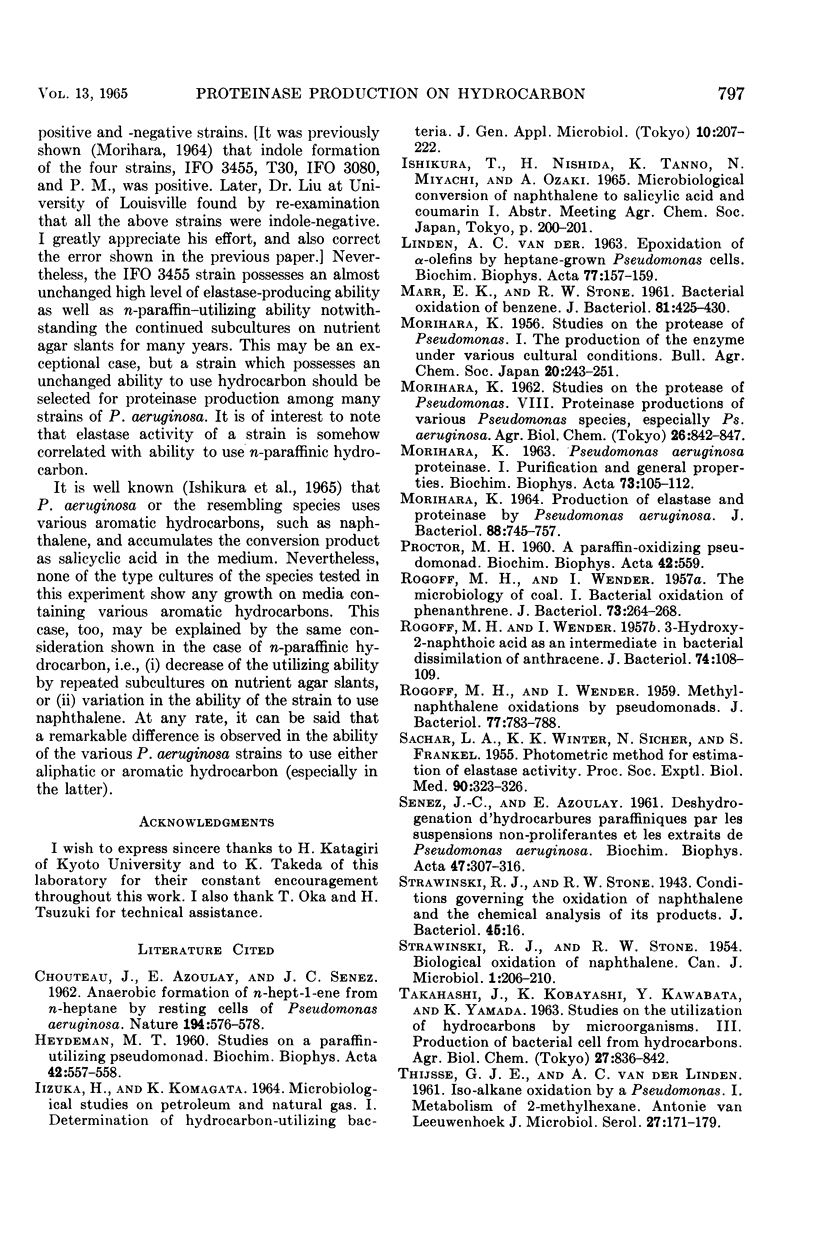Abstract
Proteinase production by Pseudomonas aeruginosa was studied in medium containing noncarbohydrate materials, especially various hydrocarbons, as the sole carbon source. On heavy oil, kerosene, n-paraffinic hydrocarbon of C12, C14, or C16, and propylene glycol, the bacteria grew well and high protinase production was observed. However, production on paraffinic hydrocarbon differed remarkably with strains of varied origins. The elastase-positive strain, IFO 3455, showed abundant growth and high proteinase production on medium containing a paraffin of C12, C14, or C16, whereas the elastase-negative strain, IFO 3080, showed little growth on the same medium. Neither elastase-positive nor elastase-negative strains, however, utilized n-paraffins of C5 to C10, or various aromatic hydrocarbons such as benzene, naphthalene, phenanthrene, and anthracene. The proteinases produced on the noncarbohydrate medium were identical with those produced in glucose medium.
Full text
PDF




Selected References
These references are in PubMed. This may not be the complete list of references from this article.
- HEYDEMAN M. T. Studies on a paraffin-utilizing pseudomonad. Biochim Biophys Acta. 1960 Aug 26;42:557–558. doi: 10.1016/0006-3002(60)90846-5. [DOI] [PubMed] [Google Scholar]
- MARR E. K., STONE R. W. Bacterial oxidation of benzene. J Bacteriol. 1961 Mar;81:425–430. doi: 10.1128/jb.81.3.425-430.1961. [DOI] [PMC free article] [PubMed] [Google Scholar]
- MORIHARA K. PRODUCTION OF ELASTASE AND PROTEINASE BY PSEUDOMONAS AERUGINOSA. J Bacteriol. 1964 Sep;88:745–757. doi: 10.1128/jb.88.3.745-757.1964. [DOI] [PMC free article] [PubMed] [Google Scholar]
- POMERANZ Y. Inactivation of alpha-amylases by synthetic detergents. Biochim Biophys Acta. 1963 May 7;73:105–112. doi: 10.1016/0006-3002(63)90425-6. [DOI] [PubMed] [Google Scholar]
- PROCTOR M. H. A paraffin-oxidizing pseudomonad. Biochim Biophys Acta. 1960 Aug 26;42:559–559. doi: 10.1016/0006-3002(60)90847-7. [DOI] [PubMed] [Google Scholar]
- ROGOFF M. H., WENDER I. 3-Hydroxy-2-naphthoic acid as an intermediate in bacterial dissimilation of anthracene. J Bacteriol. 1957 Jul;74(1):108–109. doi: 10.1128/jb.74.1.108-109.1957. [DOI] [PMC free article] [PubMed] [Google Scholar]
- ROGOFF M. H., WENDER I. Methylnaphthalene oxidations by pseudomonads. J Bacteriol. 1959 Jun;77(6):783–788. doi: 10.1128/jb.77.6.783-788.1959. [DOI] [PMC free article] [PubMed] [Google Scholar]
- ROGOFF M. H., WENDER I. The microbiology of coal. I. Bacterial oxidation of phenanthrene. J Bacteriol. 1957 Feb;73(2):264–268. doi: 10.1128/jb.73.2.264-268.1957. [DOI] [PMC free article] [PubMed] [Google Scholar]
- SACHAR L. A., WINTER K. K., SICHER N., FRANKEL S. Photometric method for estimation of elastase activity. Proc Soc Exp Biol Med. 1955 Nov;90(2):323–326. doi: 10.3181/00379727-90-22022. [DOI] [PubMed] [Google Scholar]
- SENEZ J. C., AZOULAY E. [Dehydrogenation of paraffin hydrocarbons by non-proliferating suspensions and extracts of Pseudomonas aeruginosa]. Biochim Biophys Acta. 1961 Feb 18;47:307–316. doi: 10.1016/0006-3002(61)90291-8. [DOI] [PubMed] [Google Scholar]
- STRAWINSKI R. J., STONE R. W. Biological oxidation of naphthalene. Can J Microbiol. 1954 Dec;1(3):206–210. doi: 10.1139/m55-027. [DOI] [PubMed] [Google Scholar]
- THIJSSE G. J., van der LINDEN A. Iso-alkane oxidation by a Pseudomonas. I. Metabolism of 2-methylhexane. Antonie Van Leeuwenhoek. 1961;27:171–179. doi: 10.1007/BF02538437. [DOI] [PubMed] [Google Scholar]
- VAN DER LINDEN A. C. EPOXIDATION OF ALPHA-OLEFINS BY HEPTANE-GROWN PSEUDOMONAS CELLS. Biochim Biophys Acta. 1963 Sep 3;77:157–159. doi: 10.1016/0006-3002(63)90484-0. [DOI] [PubMed] [Google Scholar]


